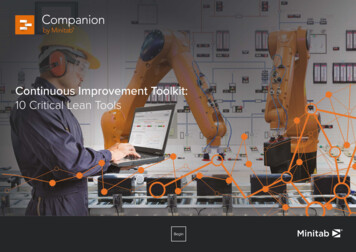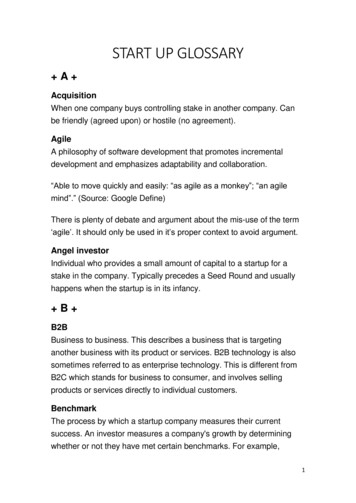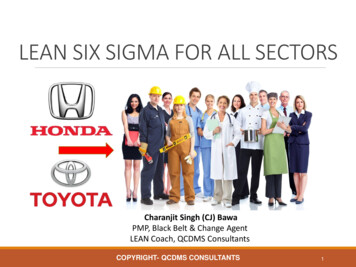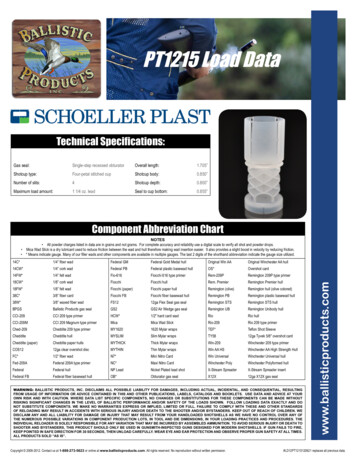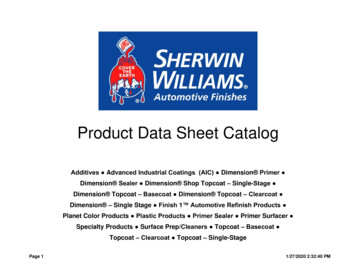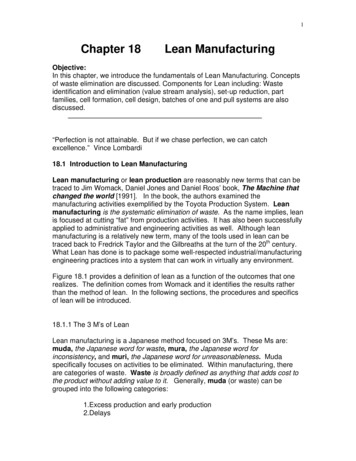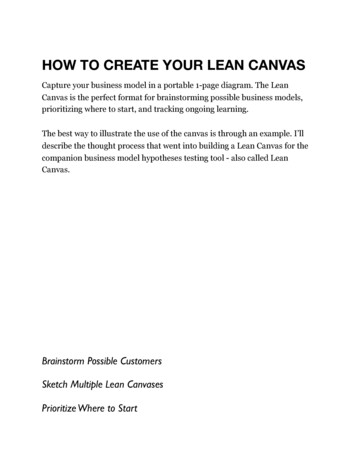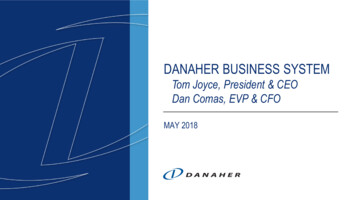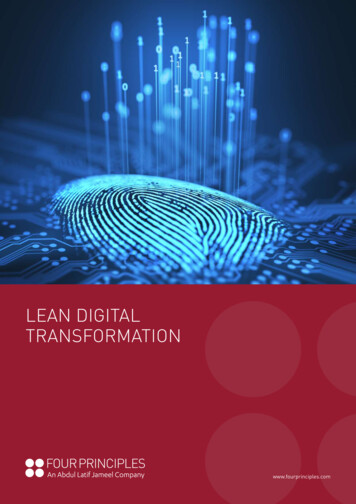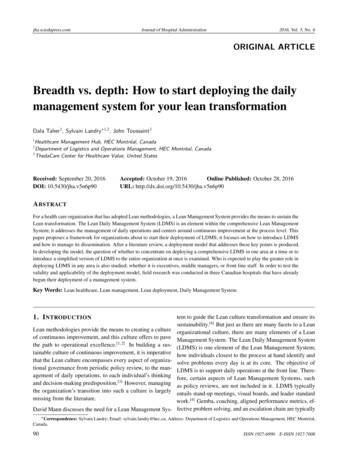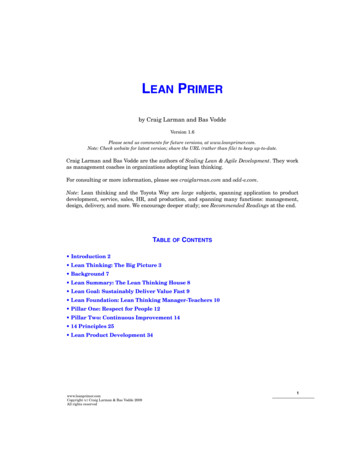
Transcription
LEAN PRIMERby Craig Larman and Bas VoddeVersion 1.6Please send us comments for future versions, at www.leanprimer.com.Note: Check website for latest version; share the URL (rather than file) to keep up-to-date.Craig Larman and Bas Vodde are the authors of Scaling Lean & Agile Development. They workas management coaches in organizations adopting lean thinking.For consulting or more information, please see craiglarman.com and odd-e.com.Note: Lean thinking and the Toyota Way are large subjects, spanning application to productdevelopment, service, sales, HR, and production, and spanning many functions: management,design, delivery, and more. We encourage deeper study; see Recommended Readings at the end.TABLE OF CONTENTS Introduction 2 Lean Thinking: The Big Picture 3 Background 7 Lean Summary: The Lean Thinking House 8 Lean Goal: Sustainably Deliver Value Fast 9 Lean Foundation: Lean Thinking Manager-Teachers 10 Pillar One: Respect for People 12 Pillar Two: Continuous Improvement 14 14 Principles 25 Lean Product Development 34www.leanprimer.comCopyright (c) Craig Larman & Bas Vodde 2009All rights reserved1
Lean PrimerINTRODUCTIONI have enough money to last me the rest of my life,unless I buy something.—Jackie MasonLean thinking is a proven system that applies to product development and production,as evidenced by Toyota and others. And although most often applied to products, it isalso used in service areas—both within Toyota and in domains such as health care1.The image and metaphor we like to convey a key thinking mistake—and opportunity—is the sport of relay racing.Consider the relay racers standing around waiting for the batonfrom their running colleague. The accountant in the finance department, looking aghast at this terrible underutilization ‘waste’ indicated in some report, would probably mandate a policy goal of “95%utilization of resources” to ensure all the racers are busy and ‘productive.’ Maybe—he suggests—the runners could run three races atthe same time to increase “resource utilization,” or run up a mountain while waiting.Funny but this kind of thinking lies behind much of traditional management andprocesses in development and other domains.2 Of course, in contrast, here is a centralidea in lean thinking:Watch the baton, not the runners.1. For readers working in service domains, note that most lean principles are very general, such as continuous improvement mindset and manager-teachers who are workexperts and act as mentors. Some principles require minor translation, such as longterm great engineers to long-term great hands-on workers, or new product development to new service.2. See, for example, PRTM [McGrath96, McGrath04] for collections of traditional—andun-lean—product development ideas.2
Lean Thinking: The Big PictureDoes your organization measure “productivity” or “efficiency” in terms of how busypeople are, or time spent—watching the runner? Or, in terms of fast delivery of valueto the real customer—watching the baton? What is the value-to-waste ratio in yourwork? And what are the impediments to the flow of value—and how can people feelinspired to continuously strive to improve that flow? Lean thinking addresses this.LEAN THINKING: THE BIG PICTURELean (or lean thinking) is the English name—popularized by MIT researchers—todescribe the system now known as the Toyota Way inside the company that createdit.3 Toyota is a strong, resilient, company that seems to improve over time:– In 2008 surpassed GM tobecome the largest vehiclecompany by sales, while beingmuch more profitable.– Market capitalization in May2007 was over 1.5 times thatof GM, Ford, and DaimlerChrysler combined.– J.D. Power (etc.) consistentlyrate Toyota, Lexus, and Scionamong the top in quality.– Innovative with social andenvironmental awareness—forexample, creator of the Priusand hybrid technology.– In 2006 profit was 13.7 USDbillion, while GM and Fordreported losses.a– Product development at levelsup to twice as fast as somecompetitors.a. In 2009, after the worldwide financial crisis, GM entered bankruptcy protection. Toyota, while suffering losses along with otherautomotive companies, remains solvent.This is a sample; Extreme Toyota [OST08] dedicates a chapter comparing their sustainable performance compared to others in their industry. That said, Toyota is far fromperfect and there are unique things to learn from other systems (such as agile methodsin software development) that are not found in lean thinking. We are not suggestingthat Toyota or lean thinking is the only model to learn from, or to simply emulate it.Nevertheless it is a long-refined meritorious system from a relatively robust and sustainable company.3. The original name was Respect for Humanity System. Some called it The ThinkingWay. These emphasized a Toyota culture of mentoring people to think through andresolve root causes to problems, to help society, and to humanize work [Fujimoto99,WJR90].www.leanprimer.comCopyright (c) Craig Larman & Bas Vodde 2009All rights reserved3
Lean PrimerThe Pillars of Lean Are Not Tools and Waste ReductionThere are some common misconceptions about lean. This primer starts with clearingthese away.What is the essence and power of lean thinking and Toyota?When I first began learning about TPS4, I was enamored of the power of [one-pieceflow, kanban, and other lean tools]. But along the way, experienced leaders withinToyota kept telling me that these tools and techniques were not the key to TPS.Rather the power behind TPS is a company’s management commitment to continuously invest in its people and promote a culture of continuousimprovement. I nodded like I knew what they were talking about, and continuedto study how to calculate kanban quantities and set up one-piece flow cells. Afterstudying for almost 20 years and observing the struggles [other] companies havehad applying lean, what these Toyota teachers told me is finally sinking in.[Liker04] (emphasis added)Wakamatsu and Kondo, Toyota experts, put it succinctly:The essence of [the Toyota system] is that each individual employee is given theopportunity to find problems in his own way of working, to solve them and to makeimprovements. [Hino06]Management Tools Are Not a Pillar of LeanThe above quotes underscore a vital point because over the years there have been someostensibly ‘lean’ promoters that reduced lean thinking to a mechanistic superficiallevel of management tools such as kanban and queue management. These derivativedescriptions ignore the central message of the Toyota experts who stress that theessence of successful lean thinking is “building people, then building products” and aculture of “challenge the status quo” continuous improvement [Hino06].Reducing lean thinking to kanban, queue management and other tools is like reducinga working democracy to voting. Voting is good, but democracy is far more subtle anddifficult. Consider the internal Toyota motto shown in a photo we took when visiting4. Toyota Production System (TPS) is the precursor to the Toyota Way [Ohno88].4
Lean Thinking: The Big PictureToyota in Japan some years ago; it captures the heart of lean, summarizing their focuson educating people to become skillful systems thinkers:To simplify lean thinking to tools is to fall into a trap repeated many times before bycompanies superficially and unsuccessfully attempting to adopt what they thoughtwas lean. it was only after American carmakers had exhausted every other explanation forToyota’s success—an undervalued yen, a docile workforce, Japanese culture, superior automation—that they were finally able to admit that Toyota’s real advantage was its ability to harness the intellect of ‘ordinary’ employees.[Hamel06]Consequently, Lean Six Sigma5 is viewed by Toyota people to represent Six Sigmatools but not to represent real lean thinking. A former Toyota plant and HR managerexplains:Lean six sigma is a compilation of tools and training focused on isolated projectsto drive down unit cost The Toyota approach [ ] is far broader and far deeper.The starting point is the Toyota Way philosophy of respect for people and continuous improvement. The principle is developing quality people who continuallyimprove processes The responsibility lies, not with black belt specialists, butwith the leadership hierarchy that runs the operation and they are teachers andcoaches. [LH08]Waste Reduction Is Not a Pillar of LeanThe book Lean Thinking [WJ96] was justifiably popular and introduced some Toyotaideas to a much wider audience. We recommend it—while observing that it presents acondensed view of the Toyota system. Lean Thinking draws significantly on researchfrom the 1980s and early 1990s that focused on Toyota’s production system [WJR90],and was published before Toyota’s own Toyota Way 2001 “Green Book,” that summa5. Lean Six Sigma is an amalgam of tools promoted in the Six Sigma movement[George02].www.leanprimer.comCopyright (c) Craig Larman & Bas Vodde 2009All rights reserved5
Lean Primerrized the priority of the broader principles from an insider’s perspective. The subtitle ofLean Thinking is Banish Waste and Create Wealth in Your Organization, and so notsurprisingly, those who have read only that one book often summarize lean as “removing waste.”Although useful, waste reduction is not a pillar of lean; it is only mentioned severallevels deep within the Toyota Way 2001. Plus, in Lean Thinking, some preeminent leanprinciples such as Go See (that Toyota highlights) are treated in an entertaining butonly anecdotal or secondary style that make it possible to miss the relative importanceof some lean principles within Toyota. Study Lean Thinking, and study more of theRecommended Readings.The Two Pillars of LeanWhat are the pillars of lean? Toyota president Gary Convis:The Toyota Way can be briefly summarized through the two pillars that support it:Continuous Improvement and Respect for People. Continuous improvement,often called kaizen, defines Toyota’s basic approach to doing business. Challengeeverything. More important than the actual improvements that individuals contribute, the true value of continuous improvement is in creating an atmosphere ofcontinuous learning and an environment that not only accepts, but actuallyembraces change. Such an environment can only be created where there isrespect for people—hence the second pillar of the Toyota Way. (emphasis added)And from Toyota CEO Katsuaki Watanabe:The Toyota Way has two main pillars: continuous improvement and respect forpeople. Respect is necessary to work with people. By “people” we mean employees,supply partners, and customers. We don’t mean just the end customer; on theassembly line the person at the next workstation is also your customer. That leadsto teamwork. If you adopt that principle, you’ll also keep analyzing whatyou do in order to see if you’re doing things perfectly, so you’re not troubling your customer. That nurtures your ability to identify problems, and if youclosely observe things, it will lead to kaizen—continuous improvement. The rootof the Toyota Way is to be dissatisfied with the status quo; you have to askconstantly, “Why are we doing this?” (emphasis added)Respect for people and continuous improvement “challenge everything” “embracechange” mindset, the pillars of lean, are expanded later. If a lean adoption program6
Backgroundignores the importance of these—a cargo cult lean adoption6—then the essentialunderstanding and conditions for sustainable success with lean will be missing.BACKGROUNDThe English term ‘lean’ was popularized for the Toyota system—by MIT researchers ofToyota in The Machine That Changed the World [WJR90]—to contrast their lean production with the alternative of mass production. The implication was a dramaticreduction in work-package or batch size, and no longer competing on economies ofscale but rather competing on the ability to adapt, avoid inventory, and work in verysmall units. The term lean is now also used within Toyota; for example, in their ToyotaWay 2001 internal booklet.Two of the authors of the The Machine That Changed the World went on to write LeanThinking, a popular introduction that summarized five principles.Relatively broad descriptions of the lean system are The Toyota Way, The Toyota Product Development System, Inside the Mind of Toyota, Extreme Toyota, and Lean Productand Process Development. All are based on long study of Toyota. The Toyota Way[Liker04] text is used by Toyota for education, in addition to their internal Toyota Way2001. This introduction to lean is similar to these descriptions.6. A cargo cult in a tribal society performed rituals imitating the behavior of nonnative visitors (often from Europe). By analogy, cargo cult process adoption suggestsritualism and superficiality. Cargo cult lean adoption implies adopting lean toolswithout the transformation to a lean state of mind and behavior by management.www.leanprimer.comCopyright (c) Craig Larman & Bas Vodde 2009All rights reserved7
Lean PrimerFigure 1.1 the lean-thinking houseSustainable shortest lead time, best quality and value (to peopleand society), most customer delight, lowest cost, high morale, safetyRespectfor People- don t troubleyour customer - “develop people,then build products”- no wasteful work- teams & individualsevolve their ownpractices andimprovements- build partners withstable relationships,trust, and coachingin lean thinking- develop teamsProduct Development- long-term great engineers- mentoring from managerengineer-teacher- cadence- cross-functional- team room visual mgmt- entrepreneurial chiefengineer/product mgr- set-based concurrent dev- create more knowledge14 Principleslong-term, flow, pull, lessvariability & overburden,Stop & Fix, master norms,simple visual mgmt, goodtech, leader-teachers fromwithin, develop exceptionalpeople, help partners belean, Go See, consensus,reflection & kaizenContinuousImprovement- Go See- kaizen- spread knowledge- small, relentless- retrospectives- 5 Whys- eyes for waste* variability, overburden, NVA .(handoff, WIP,info scatter,delay, multitasking, defects,wishful thinking.)- perfection challenge- work toward flow(lower batch size,Q size, cycle time)Management applies and teaches lean thinking,and bases decisions on this long-term philosophyLEAN SUMMARY: THE LEAN THINKING HOUSEFigure 1.1 summarizes the modern Toyota Way in a “lean thinking house” diagram,because an earlier version of the Toyota system was first summarized within Toyota bya similar house diagram7. This house also defines the major sections of this primer,7. Fujio Cho, who later become Toyota chairman, sketched the first “Toyota ProductionSystem house” diagram in 1973.8
Lean Goal: Sustainably Deliver Value Fastsuch as Respect for People and Continuous Improvement. The remainder of the primerfollows the major elements of the diagram in the following order:4. pillar—continuousimprovement1. goal (roof)2. foundation3. pillar—respect forpeople5. 14 principles6. lean product developmentLEAN GOAL: SUSTAINABLY DELIVER VALUE FASTSustainable shortest lead time, best quality and value (to people and society), mostcustomer delight, lowest cost, high morale, tinuousImprovementRespect forPeopleGoalBroadly, the global or system goal of lean thinking is toquickly deliver things of value (to the customer and society) in shorter and shorter cycle times of all processes,while still achieving highest quality and morale levels—flow of value to the customer without delay. Toyota strivesto reduce cycle times, but not through cutting corners,reducing quality, or at an unsustainable or unsafe pace;rather, by relentless continuous improvement, thatrequires a company culture of meaningful respect for people in which people feel they have the personal safety tochallenge and change the status quo.We see echoes of this goal in the words of the creator of the Toyota Production System(TPS), Taiichi Ohno:All we are doing is looking at the time line, from the moment the customer gives usan order to the point where we collect the cash. And we are reducing the time lineby reducing the non-value-adding wastes.8 [Ohno88]So, a focus of lean is on the baton, not the runners—removing the bottlenecks to fasterthroughput of value to customers rather than locally optimizing by trying to maximizeutilization of workers or machines.8. This allusion to wastes is explored later. ‘Waste’ has an important and specific meaning in lean thinking.www.leanprimer.comCopyright (c) Craig Larman & Bas Vodde 2009All rights reserved9
Lean PrimerNot only does Toyota (and their Lexus and Scion brands) manufacture vehicles, butalso successfully and efficiently develop new products—lean principles apply to product development. How does Toyota achieve the “global goal” in their two main processes, product development and production? Development—out-learn the competition, through generating more usefulknowledge and using and remembering it effectively. Production—out-improve the competition, by a focus on short cycles, smallbatches and queues, stopping to find and fix the root cause of problems, relentlessly removing all wastes (waiting, handoff, ).This primer returns to out-learn and out-improve later on. Of course, these approachesare not mutually exclusive. Toyota Development improves and Production learns.LEAN FOUNDATION: LEAN THINKING MANAGER-TEACHERSManagement applies and teaches lean thinking, and bases decisions on this longterm nContinuousImprovementRespect forPeopleGoalWhen we first visited Toyota in Japan, we interviewedpeople to learn more about their management culture andeducation system. One of the things we learned is thatmost new employees first go through several months ofeducation before starting other work. During this periodthey learn the foundations of lean thinking, they learn tosee ‘waste’ (a subject we will return to), and they dohands-on work in many areas of Toyota. In this way, newToyota people learn problem solving through hands-on improvement experiments learn to see how lean thinking applies in different domains learn kaizen mindset (continuous improvement) appreciate a core principle in Toyota called Go See and gembaGo See means people—especially managers—are expected to “go see with their owneyes” rather than sit behind desks or believe that the truth can be learned only fromreports or numbers. It is related to appreciating the importance of gemba—going to thephysical front-line place of value work where the hands-on value workers are.10
Lean Foundation: Lean Thinking Manager-TeachersMichikazu Tanaka, a student of Taiichi Ohno, summarized the lessons he learned:You can’t come up with useful kaizen [improvement] sitting at your desk Wehave too many people these days who don’t understand the workplace Theythink a lot, but they don’t see. I urge you to make a special effort to see what’s happening in the workplace. That’s where the facts are. [SF09]We also learned that potential executive managers have worked their way up throughyears of hands-on lean thinking practice and mentoring to others. When Eiji Toyodawas president, he said to the management team, “I want you actively to train your people on how to think for themselves” [Hino06]. Note that this is not simply a message oflet people think for themselves. Rather, the management culture is managers act asteachers of thinking skills. Toyota managers are educated in lean thinking, continuous improvement, root cause analysis, the statistics of variability, and systems thinking—and coach others in these thinking tools.From this, we came especially to appreciate that for successful adoption of lean, thereare management qualities needed for any meaningful, sustained success—the leadership team cannot “phone in” their lean support. Toyota is one of few companies thatseems to demonstrate these qualities; to summarize [OST08]: Long-term philosophy—many in the company are educated in lean thinkingthrough courses and mentoring from manager-teachers. Long-term philosophy—virtually all management, including the executive level,must have a solid understanding of lean principles, have lived them for years,and teach them to others. Long-term philosophy—manager-teachers have cultivated systems thinking andprocess-improvement problem-solving thinking skills, and they teach it to others.The culture is imbued with the mentality and behavior, “Let’s stop and understand the root causes of problems.”Manager-teachers—the internal motto isGood Thinking, Good Products. How do theyachieve this “good thinking” which forms thefoundation of their success? It is through a culture of mentoring. Managers are expected to behands-on masters of their domain of work (thesaying is, “my manager can do my job better than me”), are expected to understandlean thinking, and are expected to spend time teaching and coaching others. Welearned during an interview in Japan that Toyota HR policies include analysis of howmuch time a manager spends teaching. In short, managers are less directors and morewww.leanprimer.comCopyright (c) Craig Larman & Bas Vodde 2009All rights reserved11
Lean Primerteachers in the principles of lean thinking, “stop and fix right,” and kaizen mentality.In this way, the Toyota DNA is propagated [LH08].Atsushi Niimi, Toyota North America president, said that the greatest challenge inteaching the Toyota Way to foreign managers was, “They want to be managers, notteachers.”In [Liker03], a matrix of management cultures is presented; ideal lean manager-teachers are in the top-left quadrant—bottom-up consensus builders and real team leaderswho are work experts, and who mentor their team members:expert knowledge of the only general managementworkknowledgebottom-upcoach/mentor; builder of alearning organizationfacilitatortop-downdetailed task masterbureaucratThe more one learns about lean, the more one appreciates that the foundation is manager-teachers who live and teach it and have long hands-on experience. The foundationis not tools or waste reduction.Any executive team that wants to succeed with lean thinking will need to pay attention to this basic lesson—that they cannot “phone in” their support to “do lean.”PILLAR ONE: RESPECT FOR ntinuousImprovementRespect forPeopleGoalRespect for people sounds nebulous, but includes concreteactions and culture within Toyota. They broadly reflectrespect for and sensitivity to morale, not making people dowasteful work, real teamwork, mentoring to develop skillful people, humanizing the work and environment, safeand clean environment (inside and outside of Toyota), andphilosophical integrity among the management team.Figure 1.2 illustrates some implications.
Pillar One: Respect for PeopleFigure 1.2 respect for peopleDon t Trouble Your Customer - your customer is anyone whoconsumes your work or decisions“Develop People and ThenBuild Products”- managers act as teachers, notdirectors- relentlessly analyze and change tostop troubling them- don t force people to do wasteful work- don t give them defects- don t make them wait- mentor people closely, for years, inengineering and problem solving- teach people to analyze rootcauses and make problems visible;then they discover how to improve- don t impose wishful thinking on them- don t overload themLean “Respectfor People”Teams & Individuals EvolveTheir Own Practices &Improvements- management challengespeople to change and mayask what to improve , but - workers learn problem solvingand reflection skills and then.Managers“Walk the Talk”managers understand andact on the goal of“eliminating waste” and“continuous improvement”in their own actions anddecisions—andemployees see thisDevelop Teams- real, jelled teams of 5-6 people- team-work, not group-work, culture- decide how to improveBuild Partners- form long relationships based on trust- help partners improve and stay profitablewww.leanprimer.comCopyright (c) Craig Larman & Bas Vodde 2009All rights reserved13
Lean PrimerPILLAR TWO: CONTINUOUS IMPROVEMENTContinuous improvement is based on several ideas: kaizen perfection challenge work toward flow (covered in the 14 sImprovementGo SeeRespect forPeopleGoal FoundationGo See for Yourself (Go See)Go to the source [the place of real value work—gemba] to find the facts to makecorrect decisions, build consensus, and achieve goals at our best speed. [Toyota01]Go See is a principle not found in many management cultures. This principle isdescribed as critical and fundamental. In the internal Toyota Way 2001 it is highlighted as the first factor for success in continuous improvement. Go See shows uprepeatedly in Toyota manager quotes, in Toyota culture and habits [LH08], in education on the Toyota Way, and in the research done by Japanese analysts of lean thinking(for example, [OST08]). All that said, it is missing from some derivative ‘lean’ descriptions and so—unfortunately—some are unaware of its vital role.In a lean-thinking culture, all people, but especially managers—including senior managers—should not spend all their time in separate offices or meeting rooms, receivinginformation via reports, computers, management reporting tools, and status meetings.Rather, to know what is going on and help improve (by eliminating the distortion thatcomes from indirect information), management should frequently go to the place of realwork and see and understand for themselves. This “real front-line place of work”(gemba) does not mean proximity to the building where work happens, nor does itmean going to visit other managers. It implies to be as physically close to the realfront-line work as possible—not sitting in an office nearby, but “breathing the sameair.” ‘Work’ in lean does not primarily mean the overhead or secondary work ofaccounting and so on, but the value-adding work that the customer cares about—engineering, designing a car, producing things, delivering customer service.An example of Go See is for managers to regularly visit and then sit with hands-onengineers or service-delivery people while they are working, with the aim of under-14
Pillar Two: Continuous Improvementstanding problems and opportunities to improve. It is similar to the unfortunatelynow-lost HP practice of “management by walking around.”In an interview, Toyota’s chief engineer quoted Taiichi Ohno, who insisted on managerspracticing Go See at gemba:Don’t look with your eyes, look with your feet people who only look at the numbers are the worst of all. [Hayashi08]The Japanese term for Go See, genchi genbutsu, has also been broadly rendered asimplying solve problems at the source instead of behind desks. Go See not only implieswalking to the source to find facts and decide with direct insight; it means—once youare there—to build consensus for goals and experiments to change. The full implicationof Go See is for people—especially managers—to frequently spend time at the realplace of value work, build relationships of trust with the people there, and help themfix things.For example, Figure 1.3 shows a picture of Craig’s ‘office’ in Bangalore, Valtech India: alittle desk physically among hands-on teams. He has spent time sitting with the realworkers while they work, and attending their kaizen events. In this way, getting adirect understanding of what’s working and what’s not—and how to better help.Figure 1.3 ‘office’—Go See attitudewww.leanprimer.comCopyright (c) Craig Larman & Bas Vodde 2009All rights reserved15
Lean PrimerKaizenImprove for improvements’ sake, endlessly.Kaizen is sometimes translated as simply “continuous improvement” but that confuses it with the broader lean pillar of “continuous improvement” and does not capturethe full flavor. So, we will stick with the Japanese term.9Kaizen is both a personal mindset and a practice. As a mindset, it suggests “My work isto do my work and to improve my work” and “continuously improve for its own sake.”More formally as a practice, kaizen implies:1. choose and practice techniques the team has agreed to try, until they are wellunderstood—that is, master standardized work2. experiment until you find a better way3. repeat foreverStep 1—Choose and practice techniques the team has agreed to try, until theyare well understood (master standardized work). The idea is for a group to firstfind (hopefully) skillful baseline practices and learn to do them well. People learn to do X in a standardized way, with plenty of practice, coaching, and good education. Stepone in kaizen implies having patience through the awkward learning phase and notabandoning new techniques quickly. People need a valid baseline to improve against.And in Deming’s terminology, they need to be able to distinguish between commoncause and special-cause variability.This step-one point of kaizen is that a person or team cannot accurately see if theyneed to improve or change a practice unless they have first mastered the basics, understood its subtle points, and can do it well. Have you ever seen, “Oh, X doesn’t work”comments that were based on insufficient skill, practice, or education? There is nopoint in ‘improving’ or rejecting based on misunderstanding.In lean thinking, standardized work does not mean conforming to centralizedstandards—A gross misunderstanding of lean thinking is the notion that “standardized work” means conformance to centrally-defined standards. This is such a profoundmistake from the lean perspective, yet so easily misunderstood, that this pointdeserves special emphasis. Rather, the idea is for a team to master a baseline againstwhich improvement experiments can be compared. This baseline—the standard—is9. We avoid Japanese terms unless no English term works.16
Pillar Two: Continuous Improvementcreated by the team themselves (not by a centra
Lean Primer INTRODUCTION I have enough money to last me the rest of my life, . Lean Six Sigma5 is viewed by Toyota people to represent Six Sigma . and was published before Toyota’s own Toyota Way 2001 “Green Book,” that summa-5. Lean Six Sigma is an amalgam of tools promoted
